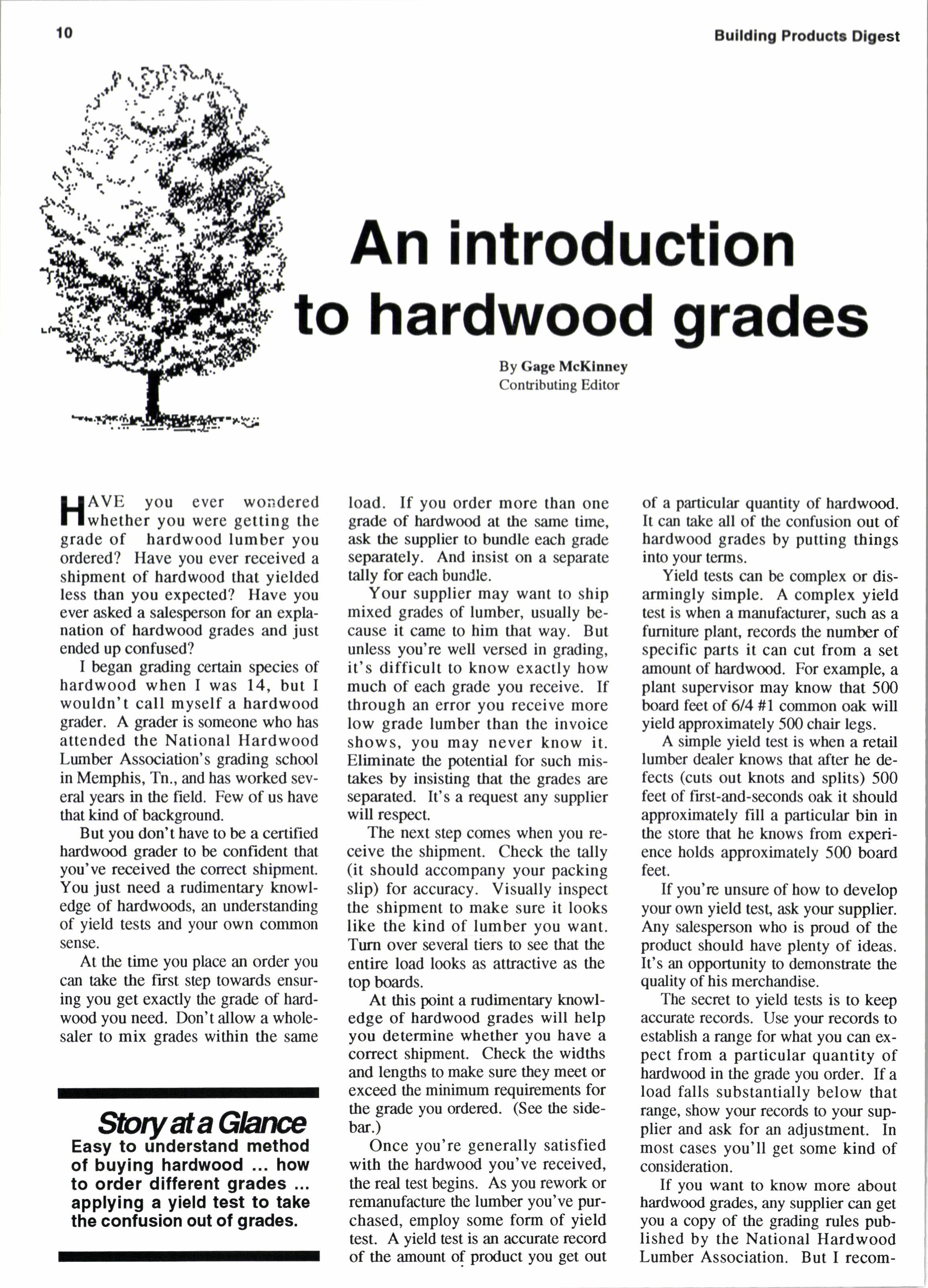
3 minute read
An introduction to hardwood grades
By Grge McKlnney Contsibuting Edilor
AVE you ever wondered whether you were getting the grade of hardwood lumber you ordered? Have you ever received a shipment of hardwood that yielded less than you expected? Have you ever asked a salesperson for an explanation of hardwood grades and just ended up confused?
I began grading certain species of hardwood when I was 14, but I wouldn't call myself a hardwood grader. A grader is someone who has attended the National Hardwood Lumber Association's grading school in Memphis, Th., and has worked several years in the field. Few of us have that kind of background.
But you don't have to be a certified hardwood grader to be confident ttrat you've received the correct shipmenl You just need a rudimentary lnowledge of hardwoods, an understanding of yield tests and your own cornmon sense.
At the time you place an order you can take the frst step towards ensuring you get exactly the grade of hardwood you need. Don't allow a wholesaler to mix grades within the same
SrbryataGlarre
Easy to rinderstand method of buying hardwood ... how to order different grades applying a yield test to take the confusion out of grades.
load. If you order more tban one grade of hardwood at tbe same time, ask the supplier to bundle each grade separately. And insist on a sepafate tally for each bundle.
Your supplier may want to ship mixed grades of lumber, usually because it came to him that way. But unless you're well versed in grading, it's difficult to know exactly how much of each grade you receive. If through an error you receive more low grade lumber than the invoice shows, you may never know it. Eliminate the potential for such mistakes by insisting that the grades are separated. It's a request any supplier will respect
The next step comes when you receive the shipment. Check the tally (it should accompany your packing slip) for accuracy. Visually inspect the shipment to make sure it looks like the kind of lumber you want. Turn over several tiers to see that the entire load looks as attractive as the top boards.
At this point a rudimentary lnowledge of hardwood grades will help you determine whether you have a correct shipment. check the widths and lengths to make sure they meet or exceed the minimun requirements for the grade you ordered. (See the sidebar.)
Once you're generally satisfied with the hardwood you've received, the real test begins. As you rework or remanufacture the lumber you've purchased, employ some form of yield test. A yield test is an accurate record of the amount of product you get out of a particular quantity of hardwood. It can take all of the confusion out of hardwood grades by putting things ino your tenns.
Yield tests can be complex or disanningly simple. A complex yield test is when a manufacnrer, such as a furniture planL records the number of specific parts it can cut from a set anount of bardwood. For exarnple, a plant supervisor may know that 500 board feet of 614 #l cornmon oak will yield approximately 500 chair legs.
A simple yield test is when a retail lumber dealer lnows that aft€r he defects (cuts out lnots and splits) 500 feet of frst-and-seconds oak it should approxinately fill a particular bin in the store that he lnows from experience holds approximately 500 board feet.
If you're unsure of how to develop your own yield test, ask your supplier. Any salesperson who is proud of the product should have plenty of ideas. It's an opportunity to demonstrate the quality of his merchandise.
The secret to yield tests is to keep accurate records. Use your records to establish a range for what you can expect from a particular quantity of hardwood in the grade you order. Ifa load falls substantially below that range, show your records to your supplier and ask for an adjustment. In most cases you'll get some kind of consideration.
If you want to know more about hardwood grades, any supplier can get you a copy of the grading rules published by the National Hardwood Lumber Association. But I recom- mend that you don't try t0 be an expert. Use yield tests so that you can talk about hardwood in the terms you know best - in terms of your own product. That way you'll never feel at a disadvantage.
If you ever think you haven't received the product you ordered, tell your supplier immediately. Your supplier will be anxious to make it right. If you have repeated difficulties and can't get satisfaction, you can contact the state agency responsible for weights and measures.
Always assume the best from your hardwood supplier. A mistake in grade (or tally) can result from a simple mix-up of orders or from a tally clerk having a bad day. (I had a few when I was clerking.) Give your supplier a chance to fix an honest mistake. It will give him an opportunity to show how much he appreciates vour business.










